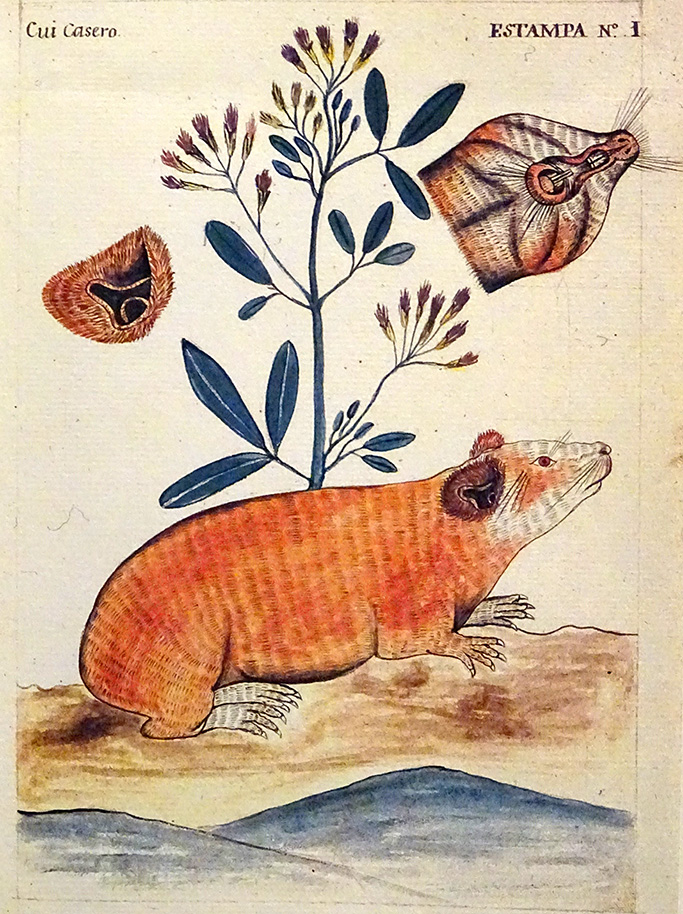Following the establishment of the Royal Cabinet of Natural History in Madrid in 1772, royal and church functionaries in the New World began shipping specimens to Madrid for analysis and exhibition, adding to a growing royal collection founded and directed by the Guayaquil-born Peruvian Creole Pedro Franco Dávila. Guinea pigs were among the many natural history specimens that made their way into the Real Gabinete, taking their place alongside the West Indian anteater and the East Indian elephant. In 1789 the bishop of Trujillo, Baltasar Jaime Martínez Compañón, sent 24 boxes of stuffed animals, plants and artefacts to the Real Gabinete, including three ceramic Chimú stirrup jars, a stuffed ‘ginger guinea pig, male’ and an illustration noting key anatomical features. Painted by an unidentified Peruvian artist who served Martínez Compañón, this illustration features a view of the rodent’s mouth, revealing its large incisors, and a close-up of the ear bones, considered to bring good luck if ingested. Compañón’s collection included both live guinea pigs and representations of the animals.
GUINEA PIG AS SPECIMEN
Helen Cowie
Further reading
- Acosta, J. (2002) Natural and Moral History of the Indies [1589], edited by J. Mangan, translated by F. López-Morillas (Durham, NC: Duke University Press).
- Asúa, M., and R. French (2005) A New World of Animals: Early Modern Europeans on the Creatures of Iberian America (Aldershot, Hampshire: Ashgate Publishing).
- Crosby, A. (1972) The Columbian Exchange: Biological and Cultural Consequences of 1492 (Westport, CT: Greenwood Press).
- Cumberland, C. (1886) The Guinea Pig, or Domestic Cavy, for Food, Fur and Fancy (London: L. Upcott Gill).
- Defrance, S. (2006) ‘The sixth toe: the modern culinary role of the guinea pig in southern Peru’, Food and Foodways, 14 (1): 3–34.
- Few, M., and Z. Tortorici (eds.) (2014) Centering Animals in Latin American History (Durham, NC: Duke University Press).
- Gade, D. (1967) ‘The guinea pig in Andean folk culture’, Geographical Review, 57 (2): 213–24.
- Maas, B. (2019) ‘Why more people in Africa should farm guinea pigs for food’, The Conversation, https://theconversation.com/why-more-people-in-africa-should-farm-guinea-pigs-for- food-108477.
- Morales, E. (1994) ‘The guinea pig in the Andean economy: from household animal to market commodity’, Latin American Research Review, 29 (3), 129–42.
- Parker Brienen, R. (2006) Visions of Savage Paradise: Albert Eckhout, Court Painter in Colonial Dutch Brazil (Amsterdam: Amsterdam University Press).
- Sandweiss, D., and E. Wing (1997) ‘Ritual rodents: the guinea pigs of Chincha, Peru’, Journal of Field Archaeology, 24 (1): 47–58.
- Yamamoto, D. (2015) Guinea Pig (London: Reaktion Books).





